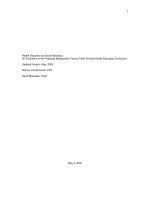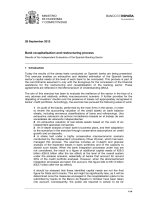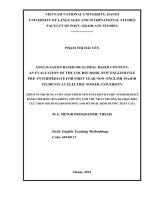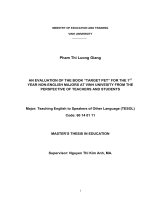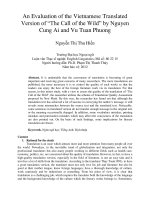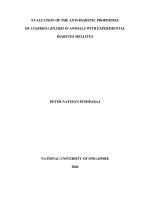EVALUATION OF THE INDEPENDENT PULIC SCHOOLS INITIATIVE(IPS)
Bạn đang xem bản rút gọn của tài liệu. Xem và tải ngay bản đầy đủ của tài liệu tại đây (394.5 KB, 44 trang )
MINISTRY OF EDUCATION & TRAINING
NATIONAL ACADEMY OF EDUCATION MANAGEMENT
Ph.D STUDENT: HA XUAN NHAM
EVALUATION OF THE INDEPENDENT
PULIC SCHOOLS INITIATIVE(IPS)
Major: Education Management
Code: 9 14 01 14
HA NOI, 2020
MINISTRY OF EDUCATION & TRAINING
NATIONAL ACADEMY OF EDUCATION MANAGEMENT
Ph.D STUDENT: HA XUAN NHAM
EVALUATION OF THE INDEPENDENT
PULIC SCHOOLS INITIATIVE (IPS)
Major: Education Management
Code: 9 14 01 14
SUPERVISORS/
INSTRUCTORS:
1. Assoc. Prof.Tran Huu Hoan. PhD
2. Assoc. Prof.Nguyen Tien Hung. PhD
HA NOI, 2020
CONTENTS
1. INTRODUCTION............................................................................................................................1
2. CONTENTS......................................................................................................................................1
2.1. EVALUATION DESIGN AND METHODS............................................................................1
2.2. EVALUTION FINDINGS.........................................................................................................2
2.3. EVALUATING THE IPS INITIATIVE....................................................................................8
2.4. FINDINGS...............................................................................................................................18
2.5. APPENDIX F: COMPONENTS OF MICHAEL BARBER DELIVEREOLOGY
MODEL...............................................................................................................................38
1. INTRODUCTION
The Centre for Program Evaluation (CPE) at the University of Melbourne
(UoM), in partnership with Shelby Consulting and Murdoch University was
contracted by the Western Australian Department of Education (DoE) to undertake
an evaluation of the Independent Public Schools (IPS) initiative. Now in its fourth
year, the IPS initiative was designed to give greater autonomy to schools, and to
reduce bureaucracy within the WA public school system (DoE, 2011). The initiative
also aims to facilitate stronger engagement between schools and their community
using different accountability processes, while still supporting schools within the
public system.
This executive summary provides a high-level summary of the key findings of the
evaluation, which was commissioned in September 2011. There were four key
evaluation questions:
1. What are the effects of the Independent Public Schools initiative on
participating schools?
2. What effect has the initiative had on the public school system overall?
3. Are there any issues that are hampering the efficiency or effectiveness of the
Independent Public Schools initiative?
4. What advice can be provided to guide future implementation of the IPS
initiative?
2. CONTENTS
2.1. EVALUATION DESIGN AND METHODS
The evaluation adopted a rigorous evaluation framework to utilise and integrate
multiple sources and forms of data, both quantitative and qualitative as well as
ensuring a high level of stakeholder continuum of readiness and adoption that is
dependent on factors such as:
•
priority for change,
•
community engagement,
•
capabilities of the leadership team,
•
the principal’s mindset, and
1
•
levels of support from the system and the community.
There are a number of impacts of the IPS initiative that emerged throughout the
evaluation. The centrality of the principal as a change agent was clearly
demonstrated. In particular, the transition period was critical, as it was the phase at
which the principals gathered the necessary resources, information and skills
required to commence and implement the initiative. These impacts are discussed, in
brief, in the sections that follow.
engagement. Data was collected across two stages and included information
accessed from the Department of Education, a survey of principals, interviews with
key stakeholders and in-depth school site visits.
2.2. EVALUTION FINDINGS
Overall, the story of the implementation of the IPS initiative is a positive one,
with the concept of IPS being agreeable to most principals in Western Australia. IPS
principals overwhelmingly maintain that even in this early phase of the
implementation, the initiative has considerably enhanced the functioning of their
school, created the opportunity to access more benefits, and that it will lead to
increased outcomes for the whole school community. Expectedly, there are
challenges and some dissenting voices particularly around issues such as:
•
increased workload, mainly in the transition to becoming IPS; and
•
the creation of a set of schools that have advantages over other schools.
The decision to apply to become IPS was a large undertaking for many schools and
while many factors come into play, a particularly relevant dynamic is that of
“readiness for change.” The rationale for those principals choosing to apply to
become IPS primarily relates to their awareness of, and desire for, the perceived
benefits of IPS. Principals chose not to apply for a range of reasons, including lack
of perceived benefits for their school, satisfaction with the status quo, insufficient
capacity for change or philosophical opposition to the concept.
2.2.1. VARYING LEVELS OF IMPLEMENTATION
Overall, the implementation of the IPS initiative is on target, although
schools are at different points on aself-belief, the belief in autonomy, feeling of
2
support and their skills of adopting suitable flexibilities. As would be expected, the
principals exhibited different levels of these attributes - the stronger the attribute,
the greater the depth of implementation.
The principals claimed that there were critical success factors to the ongoing
success of the IPS, and these included effective principals who are able to perform
as education leaders and able to build relationships with teachers and communities.
It was felt that support should be tailored to the capabilities of the principal, and
their school context; particularly for less experienced and aspiring principals of
whom there are expected to be a higher number in future IPS cohorts
2.2.2. PRINCIPALS
The mindset of the principal was one of the most critical factors in
supporting the adoption of autonomy. In particular, the mindset that is adopted
during the transition period is critical, as it is during this phase that the principals
gather the necessary resources, information and skills required to commence and
implement the initiative.
There is little doubt that in this early phase of the initiative IPS schools are
very satisfied with the initiative. IPS principals felt empowered and believed that
they were able to empower their teachers and better cater to students’ specific
needs. They were motivated by both the freedom and responsibility for selecting
their staff and receiving their budget as a single figure over which they had control.
Principals claimed high levels of change in their role, feeling more accountable and
autonomous, and more empowered to make changes and lead their staff in
improving the teaching, resources and climate of their schools. With greater
autonomy, principals argued that they were also more motivated and invested in the
success of their schools, thus encouraging a stronger sense of entrepreneurship and
engagement as school leaders: for example, this notion of mindset can be seen in
the four areas such as the principal’s important to now also monitor what happens
inside IPS classrooms over time, and for principals to use their greater autonomies
to fully realise the benefits of these perception changes within the classrooms.
3
2.2.3.TEACHERS
Another critical element of the model is the role of the teacher. It is clear
from the evaluation that principals believe that the IPS initiative has had a positive
impact on many teachers, with a number of principals reporting that IPS teachers
demonstrate an increased motivation and energy to bring about changes, while
being more empowered to initiate innovative practices which support effective
teaching and learning. The views of teachers were varied, with some expressing
enthusiasm about how becoming an IPS had led to increased collaboration,
additional resources, professional development and support tailored to their
students’ specific needs, while others voiced concerns about the impact of IPS on
workload and careers paths.
One benefit of IPS frequently noted was increased school control over
staffing, such that they are able to recruit staff appropriate for their school context
and needs, and can choose whether or not to accept redeployees. It is noted,
however, that this does not mean that redeployees are necessarily of lesser quality
but that they may not fit the purposes in the IPS schools.
It does appear that most teachers in IPS felt more professional, accountable
and in control of their careers, which has led to a greater feeling of selfworth. At
this stage in the implementation of the IPS initiative, however, these findings are
more at the level of perception and attitude. It will thus be schools, to their mutual
benefit. The other public schools did not note any particular change with their
community and as many suggested, they were relatively satisfied with their current
status.
2.2.4. SCHOOL AND COMMUNITY
Whole school cultural change is also observable in the IPS initiative. Schools
in IPS have been more engaged in strategic thinking and where school communities
as a whole believed in the vision of IPS that was championed by the principals, this
strategic thinking was more evident.
Further, schools in IPS reported increased engagement with their community
and accountability via their school board, as well as increases in school profile, and
4
school and community pride, with some parents suggesting the school was more
inviting. It was reported that some schools had also increased their level of
collaboration and sharing of resources across Within legislative and industrial
constraints, the IPS initiative essentially shifts decision-making from central office
to schools, and involves central office providing a supportive role to schools. This
has necessitated a realignment of roles, culture, systems and resources in the
Department. This process has been occurring at different rates and changing
priorities appear to have also triggered in-depth reviews of processes and policies,
with a view to providing better support to all schools including deployment of staff.
Equity was also a predominant theme, particularly for principals not in the
IPS initiative. For example, there was a common view that the optimal placements
for regional and indigenous schools need to be a focus for the sector.
The
evaluation, however, found no evidence to date to suggest that very remote, remote,
regional and metro schools were differentially impacted by the IPS initiative.
Related to this, concerns were voiced by some principals who did not apply or who
were unsuccessful in their application to take up IPS that there is the potential for a
‘two – tiered’ system to emerge. Significantly, it must be questioned as to whether
multiple ways of operating schools will be inherently negative, given the contextual
diversity of WA. It is interesting to note that schools that applied to IPS but had
not been accepted, suggested that they were seen to have failed to reach a standard,
and claimed there were negative impacts on staff morale and community confidence
as a result. However, there was no evidence of substantial differences in outcomes
between schools that were selected into IPS and those that were not.
Overall, stakeholders were positive about the implementation of the IPS
initiative. The need for continued review of central policy and processes, and a
more open central culture to better support schools was highlighted as needing to
continue and improve, along with a readiness to tackle legislative and industrial
barriers in the future.
5
2.2.5. SYSTEM
The implementation of the IPS initiative has, overall, had a positive effect on
the public school system by raising its profile and contributing to a sense of renewal
and positive reform. The complexity that occurs as a consequence of working
towards school change as well as system change, however, cannot be
underestimated. While the system has adapted to support this innovation, this
process of adaptation is still developing and it will be important to continue to
monitor this level of change and support over time. At a whole system level there
are demonstrable changes in working conditions. Changed roles and increases to the
administrative and managerial responsibilities under autonomy have inevitably
altered the workload of school leaders, although most acknowledged that this
additional burden would reduce somewhat over time, and point to benefits for IPS
school communities.
The implementation of IPS is ongoing, and there are a number of factors and
outcomes that can be considered in the medium and long term. Strengths, such as
the motivated, energised, and engaged character of the Western Australian IPS
initiative must be capitalised on, and factors which potentially limit the adoption of
the innovation must be addressed. The key theme to emerge from the evaluation
that needs to be considered is the importance of understanding a school and
principal’s readiness to adopt the IPS innovation. Considering that there are many
levels of autonomy or flexibilities that schools can adopt, schools should be
encouraged to opt in according to their level of readiness and support from their
communities. Further, the transition process is critical to the successful
implementation: most importantly, once the school level outcomes are in place,
directing the focus of support to the classroom and teacher empowerment maybe
beneficial.
Conclusions: The theory and direction of the research logic has been
validated by the evaluation results. The evaluation provided information to
determine the IPS process of change, as well as an opportunity to review and refine
the initial model, with a view to future development. While there is the sense that
6
the initiative is some way through its implementation phase, it has yet to realise a
fully developed process that can produce long-term gains. There is little doubt that
the main elements of the initial logic are core to the implementation of the IPS
initiative: the principal and the principal’s role in relation to their teachers and
school community as suggested by the evaluation’s normative model developed
early 2012.
The implementation of IPS is ongoing, and there are a number of factors and
outcomes that can be considered in the medium and long term. Strengths, such as
the motivated, energised, and engaged character of the Western Australian IPS
initiative must be capitalised on, and factors which potentially limit the adoption of
the innovation must be addressed. The key theme to emerge from the evaluation that
needs to be considered is the importance of understanding a school and principal’s
readiness to adopt the IPS innovation. Considering that there are many levels of
autonomy or flexibilities that schools can adopt, schools should be encouraged to
opt in according to their level of readiness and support from their communities.
Further, the transition process is critical to the successful implementation: most
importantly, once the school level outcomes are in place, directing the focus of
support to the classroom and teacher empowerment maybe beneficial.
There are number of considerations that emerged from the evaluation and
many of these ideas focus on targeted professional development for principals, and
critically, on teaching and learning. A number of specific elements for future focus
include:
•
Considering the development of a more structured assessment of a school’s
and principal’s readiness to engage in autonomy, one that allows for selfreview and establishing strategic targets.
•
Encouraging a direction that moves towards principals building on positive
school culture gains to focus on the classroom and empower teachers to have
greater impacts on students.
•
Enhancing the successful transition program to build another level of support
for principals ready to focus on classroom change.
7
•
Providing support for principals to develop a ‘mindset’ that aids a
progressive model of autonomy.
•
Considering the importance of community engagement and specific means of
targeted development and support (e.g., building partnerships across
schools).
•
Considering the particular role, placement and importance of redeployees.
•
Enhancing capacity around monitoring and evaluation within the sector and
the schools, particularly on the effect on school climate, attendance, and
achievement outcomes.
•
Encouraging schools to set achievement targets based on data, and to engage
in continual review of these targets.
•
Considering the current evaluation as a baseline from which to build and
ensure the evaluative data forms the basis of further progression of the
initiative.
Ultimately, this evaluation has found that the IPS initiative, while still in its
early phase and not without challenges, has set the scene for school improvement,
been embraced by most principals and had a significant impact across a range of
areas within schools and the broader system.
2.3. EVALUATING THE IPS INITIATIVE
In evaluating the IPS initiative, a staged approach was employed. The first
stage involved three steps; engaging stakeholders, clarifying the program and
focusing the evaluation design. Key activities that occurred within this stage
included conducting a number of meetings and workshops, clarifying the IPS
initiative through the development of a program logic and validated through a
literature review, and the analysis of existing DoE information on IPS
characteristics. Refer to Figure 33 for the program logic and Appendix A for the
literature review. The second stage involved two data collection phases as required
in the RFT: in-depth site visits to sample IPS, stakeholder interviews, surveys in all
Western Australian public schools and the collection of secondary data housed
within the Department of Education. The final stage revisits the program logic in
8
light of what is happening in the schools and the Department’s central services, and
integrates and analyses the evaluation information so that overall recommendations
for improvement can be made. This report will summarise information collected
across all stages of the evaluation.
2.3.1. METHODOLOGY
The following section outlines the evaluation methodology utilised, the objectives
and questions used, and the methods of data collection and analysis.
•
FRAMEWORK
The implementation of the evaluation is underpinned by the framework
developed by the Centre for Diseases Control and Prevention (CDC&P),
“Framework for Program Evaluation of Public Health Initiatives” (CDC&P, 1999).
This is an adaptation of a standard form of evaluation framework commonly used in
educational and social settings; Figure 1 demonstrates this high level framework.
The model provides an overarching framework through the application of six steps
(‘stakeholder engagement’; ‘program description’; ‘focus the evaluation design’;
‘data collection’; ‘justify conclusions’ and ‘ensure use and share lessons learned’).
These six steps are applied at various times throughout the evaluation’s three-staged
approach. The framework is underpinned by a set of standards to maintain the
accuracy, reliability and validity of the evaluation. Refer to Appendix B for the
explanation of these standards
9
Stage 1
Progra
m
Clarificatio
n
Stage 3
Testing
Integration
Analyses
Recommendations
Stage 2
Data
Collection
Figure 1: Evaluation Framework
In evaluating the IPS initiative, a mixed-methods methodology was utilised,
with respect to data collection and analysis within this framework.
Such an
approach combines qualitative and quantitative methods of inquiry, incorporating
the strengths of both methods to better address the evaluation questions and
strengthen the study design. A mixed methods approach is ‘generative and open,
seeking richer, deeper, better understanding of important facets of our infinitely
complex social world’ (Green, 2007, p.20). It enables a tailored use of different
data collection methods in order to provide the range of perspectives from the key
stakeholders in the IPS initiative, as well as, triangulation of these perspectives in
addressing the key evaluation questions.
•
EVALUATION OBJECTIVES & QUESTIONS
The WA Department of Education commissioned an evaluation of the IPS
initiative to ensure further expansion is based on a credible assessment of its
effectiveness. Consequently, the study was conceived with the agreed objectives of
examining and reporting on:
10
The implementation of the Independent Public Schools initiative and
•
whether there are opportunities for its improvement.
The impacts of the initiative on the effectiveness and efficiency of
•
Independent Public Schools and public confidence in the broader public
school system.
The extent to which the experience of schools demonstrates that the policy
•
objectives of the initiative are being met.
To guide the collection, analysis and reporting of information on each of these
objectives, four key evaluation questions were developed and agreed upon:
1.
What are the effects of the Independent Public Schools initiative on
participating schools?
2.
Are there any issues that are hampering the efficiency or effectiveness of the
Independent Public Schools initiative?
3.
What effect has the initiative had on the public school system overall?
4.
What advice can be provided to guide future implementation of the IPS
initiative?
METHODS OVERVIEW
•
Using a mixed-methods strategy, the evaluation study takes a multi-pronged
approach to data collection by collecting information appropriate to each evaluation
question.
In Stage 1, the information required was sought from:
•
In depth discussions with DoE senior staff and school principals to develop a
program logic for the implementation of the initiative.
•
Program documents sourced from the Department and the schools, such as:
guidelines,
reports,
applications/submissions,
plans,
IPS
principal
agreement
business
templates,
plans,
school
school
delivery
performance reports etc.
•
Interviews with persons who had expertise in the practice and theory of
school autonomy.
In Stage 2, information was sought from:
11
•
Secondary data, housed at the Department and at the schools, such as:
student academic outcomes; student enrolment trends; student attendance
and behaviour; teacher and other staff mobility; financial and budgeting
data. Where possible, data was collected about IPS and other public schools
over a five year period, beginning prior to the commencement of the IPS
initiative and continuing to the end of 2012 in order to enable comparisons
between schools.
•
Surveys with principals of IPS and other public schools.
•
Interviews with key stakeholders with a particular focus on staff in central
and Regional offices, and representatives of professional and staff
associations.
•
In-depth visits to a number of IPS to interview staff and parents.
Using a mixed-methods strategy, the evaluation study takes a multi-pronged
approach to data collection by collecting information appropriate to each evaluation
question.
In Stage 1, the information required was sought from:
•
In depth discussions with DoE senior staff and school principals to develop a
program logic for the implementation of the initiative.
•
Program documents sourced from the Department and the schools, such as:
guidelines,
reports,
applications/submissions,
plans,
IPS
principal
agreement
business
templates,
plans,
school
school
delivery
performance reports etc.
•
Interviews with persons who had expertise in the practice and theory of
school autonomy.
In Stage 2, information was sought from:
•
Secondary data, housed at the Department and at the schools, such as:
student academic outcomes; student enrolment trends; student attendance
and behaviour; teacher and other staff mobility; financial and budgeting
data. Where possible, data was collected about IPS and other public schools
over a five year period, beginning prior to the commencement of the IPS
12
initiative and continuing to the end of 2012 in order to enable comparisons
between schools.
•
Surveys with principals of IPS and other public schools.
•
Interviews with key stakeholders with a particular focus on staff in central
and Regional offices, and representatives of professional and staff
associations.
In-depth visits to a number of IPS to interview staff and parents.
•
SECONDARY DATA COLLECTION
Data from 2009-2012 at the school level was provided by the DoE. These
data from all 770 WA public schools were collated and merged into one database
(SPSS), including demographic information such as school name, region,
socioeconomic index (SEI), % Aboriginal students and Torres Strait Islanders,
postcode, statistical division, local government area code, treasury area code,
region, and region descriptor. Various attributes of students such as number of
students, number of ATAR, number of students with ATAR scores of 75 and over,
and students at attendance risk (regular, indicated, moderate, severe).
Further,
performance data included median ATAR, the National Assessment Program for
Literacy and Numeracy (NAPLAN) data for Years 3, 5, 7, and 9 for Numeracy,
Reading, Writing, Spelling and Grammar. Enrolment numbers for each semester for
each year, and the WA Society and Environment and Science exam scores along
with the status of schools relative to the independent status or not were also
included.
•
PRINCIPAL SURVEY
Principals from all public schools in WA were invited to participate in an
online survey exploring the following reasons for applying or not applying to
become an IPS: feedback on the transition processes into IPS for appropriate
schools; satisfaction with the principal role; teaching staff; school operation and
departmental support. The development of the survey protocol was based on a
comprehensive literature review, the program logic and discussion with
stakeholders. Four versions were prepared: for principals from IPS; for principals
13
of schools becoming IPS in 2013; for principals of schools that had unsuccessfully
applied to become IPS; and for principals of schools that had never applied. To
ensure that the questionnaire was valid and appropriate, feedback on its design and
content was sought from program stakeholders and an expert panel. The survey was
piloted with principals in order to improve the readability, appropriateness and
overall quality. Furthermore, the survey construction and analysis were designed so
as to encompass the full range of perspectives on the IPS initiative, from each
intake of IPS and all other public schools.
The survey was made live on 30th October 2012 on the Murdoch University
survey system and individualised email invitations were sent to principals of every
public school in WA. The survey was sent to a total of 772 principals. A reminder
was sent out on 5th November 2012, and again on 19th November 2012. On 29th
November 2012 a reminder was sent to schools that were not IPS to boost the
response rate of that group. Overall, there was a healthy response rate of 590
principals (76%).
•
KEY STAKEHOLDERS
Consultations were conducted with the Department’s central and Regional
office representatives, as well as union and association representatives, regarding
the overall effect of the IPS initiative on the public school system and future
implementation of the IPS initiative. The metropolitan interviews were carried out
face-to-face and regional interviews were carried out via phone with detailed notes
taken. In total, 24 interviews were conducted. A total of 22 Central office staff
participated in 10 interviews, 10 regional staff participated in 9 interviews, and 13
representatives from staff and parent unions and associations participated in 5
interviews.
In order to gain an in-depth understanding of how schools are adapting to
IPS, a small number of schools were selected by the evaluation team from the three
IPS cohorts and visits were made to each school to interview principals, staff,
parents and members of the school boards. The selection process aimed to identify
schools that have shown an innovative approach towards the initiative so that
14
lessons could be learned of how best to adapt to greater autonomy. The 13 schools
selected were distributed geographically by IPS cohort and by type of school to
maximise the variety of contexts. The table below summarises the geographical
distribution of the site-visit schools. Among these there are six primary schools,
four secondary schools, one district high school and two education support settings.
The distribution of the selected schools by Socio Economic Index was also checked
to ensure a range was included. Schools starting in the IPS initiative in 2013 were
excluded from the site visit selection, as they would not have had sufficient time to
implement the key elements of the initiative.
Site visits were conducted in 13 schools over one or two days. The three 2012
cohort schools were visited in Terms 1 and again in Term 4, the remaining ten 2010
and 2011 cohort schools were visited once during Term 2. At each visit, interviews
were conducted with as many of the stakeholder groups as possible and practicable.
For example, in some small schools all or most of the teachers were able to provide
feedback; in larger schools only a proportion of teachers attended interviews to
provide feedback.
During the visits to the selected schools individual and group interviews were
conducted with principals, deputy/associate principals, registrars, specialist and
teaching staff1 , board members and parents. Four different interview schedules
were developed for stakeholders groups including principals, deputy/associate
principals and registrars; teachers and education assistants; parents; and board
members. All interview schedules addressed the core issues surrounding the four
key evaluation questions. Notes were taken during the interviews, and then entered
into Excel for analysis.
In all, 121 interviews were carried out with a total of 289 participants
including 13 principals, approximately 25 deputy principals, 10 registrars, 130
teachers, 45 board members and 55 parents. Exact numbers of each group cannot be
distinguished because some groups had a number of different stakeholders and
1
.
15
some stakeholders could be placed in more than one group, for example parent and
board member.
DATA ANALYSIS APPROACH
Information was collected from a range of sources in both quantitative and
qualitative formats in accordance with a mixed-methodology design and to provide
an appropriate approach to the multiple contexts in this evaluation. It was important
to capture a holistic picture of the IPS initiative both as it has been intended and as
it has been implemented. This data was analysed at two levels. The first level of
analysis focussed on the collection of data using interviews, focus groups,
secondary data, surveys and program documentation. Analysis of this data was
undertaken to reduce and manage the categories while also allowing for interesting
or unexpected data to be identified.
The key stakeholder and site visit interviews were analysed by coding
according to common themes.
For the secondary data, the method of analysis by comparing IPS with other
public schools was considered. However this analysis would fail to account for the
number of years the IPS have been in operation. Instead, other public schools were
compared with IPS depending on the number of years they had been in the program
(intake). The table below shows that no schools were in IPS for the 2008 and 2009
data sets, 34 were in IPS in 2010, 98 were in IPS in 2011, and 171 were in IPS in
2012. There are 84 schools due to become IPS schools in 2013 and for the
remainder of the analyses these have been excluded – as they are neither IPS nor
other public schools.
Given that the schools in the data file constitute the population of all WA
schools, and the sample size of students across these schools is large, statistical
significance is not the most critical variable (although where appropriate it is
provided). Instead, effect-sizes have been created.
Effect-sizes (ES) are commonly used in educational research, and they
represent standardised differences between means. On the basis of a synthesis of
over 800+ meta-analyses relating to achievement, Hattie (2009) showed that in
16
education .2 or less is a “small” effect, .4 is average, and greater than .6 is large.
These approximate descriptions will be used in the subsequent analyses.
Analysis of the principal survey involved descriptive statistics summarising
information at the item level to explore all aspects of the survey. An interpretive
analysis was conducted to assess relationships and differences between groups. The
final phase of the analysis explores higher level factor structures and uses
interpretative statistics to illustrate statistical differences. Survey items were
inputted into SPSS and a factor analysis was used to explore the psychometric
properties of the survey. It was seen as appropriate to explore the properties of the
survey in sections, given the varying structure of the survey for different school
categories.
An exploratory factor analysis was used in an effort to discover common
response themes. Factor analysis is a statistical method that can be used to reduce
data sets by finding shared variation or trends. While conducting a factor analysis a
group of items, in this survey questions, are grouped together and examined for
trends. These factors can be named to communicate information with greater ease.
Items which reveal little contribution to a factor are deleted when inferential
statistics are being used.
These initial analyses gave rise to additional questions about underlying
influences shaping the implementation process. The evaluation team conducted a
cluster analysis of the principals of IPS and schools that had not applied to become
IPS, to investigate the school characteristics which contribute to perceptions of
change, actual change, and decisions to apply. Cluster analysis explores
relationships between scale scores and organises principals into groups based on the
similarity of how they respond to these scales. Finally, a structural equation model
was constructed to determine the most critical relations between the reasons for
applying to IPS and the experience of principal empowerment and benefits of
becoming an IPS.
17
Overall in Western Australia, there were 420 public schools located in
metropolitan Perth, 217 in regional areas, 85 in remote areas and 60 in very remote
areas. To determine whether region impacted survey dimensions, would suggest the
IPS initiative may have differential impacts across the education system, a series of
multivariate analysis of variance (MANOVA) were conducted. The general purpose
of a MANOVA is to determine whether multiple levels of independent variables on
their own or in combination with one another have an effect on the dependent
variables. This analysis used Intake (IPS intakes 1, 2 and 3 and other public
schools) and Region (city, regional, remote, very remote) as dependent variables.
The major interest is any interaction between Intake and Region in patterns of
principal response, as this would indicate that regions differed relative to any intake
across the dimensions of interest. As there were no main or interaction effects, it
can be concluded that Region was not a major factor in determining responses to the
IPS related dimensions. Further, there were no differences in the assignment to
clusters for IPS (chisquare = 7.46, df = 6, p=.280) or to the clusters for the other
public schools (chi-square = 9.86, df =9, p=.371). The analysis relating to SEI is
contained in the discussion section of the document and has similar results.
The second level of analysis triangulated the various data sources mentioned
above in order to confirm key findings and identify how the IPS initiative works at
the school level and centrally in the Department. In this way, key learnings could
be identified and reported to the Department.
Analysis of program documents was also conducted throughout the
evaluation using Departmental documents such as guidelines, reports and plans
relevant to the implementation of the IPS initiative. The documents were collated
and analysed for recurring events and themes identified in the literature review, the
core objectives of the IPS initiative and information relating to the evaluation
questions.
2.4. FINDINGS
This section provides a discussion of key findings of the evaluation,
structured under the four evaluation questions. The findings have been triangulated
18
from the data sources described in the Methodology section. Unless otherwise
stated, all references to principals refer to findings from the online survey of public
school principals. These findings are also divided by the relevant principal and
school category.
Illustrations and patterns from the case studies are indicated in the text.
References to a school indicate the view was consistent across many stakeholders
within the school; otherwise the stakeholder group is identified.
Feedback from key stakeholders including staff from Regional offices,
Central office, and representatives from school staff associations and unions as well
as from parent organisations has been noted as such in the text.
Feedback from IPS site visits include opinions provided by principals and
deputy/associate principals, business managers, teachers, parents and board
members. Where many of these stakeholders were in agreement it has been noted as
feedback from ‘the site visit schools’.
Findings from the analysis of departmental and public school data about students,
teachers, staff and finances are cited as “secondary data.”
2.4.1.WHAT ARE THE EFFECTS OF THE IPS INITIATIVE ON PARTICIPATING
SCHOOLS?
•
REASONS FOR APPLICATION
The reasons selected by survey respondents for applying to become IPS were
similar for all schools. Factor analysis revealed that the primary motivation was the
opportunity to select staff that matched student needs and the school ethos.
Respondents were also attracted by the flexibility and autonomy to make decisions,
improve school effectiveness and reputation, and manage their budgets. The
support available for IPS and access to related benefits was moderately influential,
especially for later intakes of IPS, and the prospect of additional work was not
perceived as an important barrier.
19
Figure 2: PrincipalSurvey- Reasonsforapplying to become IPS
(factoranalysisbyintake)
CHANGE AND VISION
Principals from all public school categories agreed that IPS have an
advantage in accessing the most suitable staff for their context and more flexibility
in use of their resources, but also a heavier administrative burden (see Figure 6).
Examples from some of the site visits illustrated that the choices that schools made
were quite specific to their particular goals and approach. Taking an overall view of
site visits, it became apparent that flexibility was not only about being able to
choose what resources to utilise but that there was also a flexibility to change
approaches if the desired changes were not occurring, or if they were and therefore
other areas became a priority. Thus, one school chose to decrease class size and put
more assistance into classes, while another chose to provide support to struggling
students away from their normal classroom. One school increased teacher
professional development while another reduced it to achieve what the school
identified as a more pressing priority. Some examples of changes are provided
below to illustrate some of the variety of approaches taken.
20
We have more flexibility for staffing and purchasing. We hired extra in the
office and extended education assistants’ time. The 0.6 has gone to full-time to be
used in areas where there are projects. We have more funding to do extra with some
kids. (Business manager).
The flexibility to employ staff in a suitable way. Instead of having a teacher
doing clerical work at a teachers' salary – get a clerical worker. We can swap a
teacher for clerical, reduce teaching staff by a little and top up with the clerical.
(Business manager).
Flexibility to react quickly and change resources – also have the ability to
select quite specific staff for specific roles. We were able to create a team of non–
timetabled teachers who support teachers in the classroom. We have 1.4 teachers,
1.0 team leader, and 2 FTE of education assistant time for supporting literacy and
numeracy additional to what we would normally have, funded by savings from
relief and a low socio economic grant. We chose this route instead of dropping
class size and adding support staff. (IPS principal: site visit)
We went into it not necessarily to improve NAPLAN results but to be able to
maintain a consistency of programs. For example, we would have funding for a
program and as soon as we had improved results we lost it. (IPS principal: site visit)
Programs have been able to put into place because we can hire staff to
support what we want to be able to do for the students. For example, we have a new
program for upper school which provides time allocated to education an assistant to
spend with weaker student – guided reading – support special needs and weaker
students. (Business manager)
The biggest challenges for IPS were associated with the administrative
changes, including learning to manage the new flexibilities, such as the one-line
budget and staffing profile, and the increased workload for administrative and
leadership staff.
Positive changes have revolved around flexibility of the one line budget and
selecting staff who want to be at my school and negative impacts have been the
increased workload associated with these. (IPS principal: survey)
21
Factor analysis of the principal survey showed consistent variations between
IPS intake groups in perceptions of change, with principals from the first intake
agreeing more strongly that they witnessed improvements in teaching, resources,
their leadership roles and community engagement in their schools. These are
described further in the following sections. This may be an indication that the IPS
from later intakes were still working through some of the challenges of transition,
and that change and satisfaction increase as schools become more accustomed to
operating as an IPS. Alternatively, it might signal a difference in attitudes between
principal cohorts.
Earlier intake IPS have also had more time to utilise their autonomy to
pursue their school vision. This is important for judging outcomes, as a
comprehensive school vision is a key focus for developing goals that reflect the
needs of the school community and form the basis of accountability (Muhammed
2009). Responses from IPS principals in respect of changes to school operation also
support the finding that earlier intake IPS may have had more time to focus on
school vision, rather than initial administrative changes to support implementation,
particularly in the use of resources and responsiveness to student needs.
The biggest changes reported by IPS principals lay in the increased control
over staffing and the budget. This was supported by comments made by principals
during site visits.
Staffing, and managing finances is allowing us to get better equipment, extra
psychologists and education assistants, and we were given extra support for
administration because of the extra work. (IPS principal: site visit)
I enjoy being an IPS school principal – the idea of being able to do what I
believe is good – outweighs any overwork – principalship is greatly enhanced by
IPS. Being able to have a $10k idea in the morning and have it okayed by the
afternoon. (IPS principal: site visit)
IPS principals also considered themselves to be more accountable,
autonomous, and empowered (see Figure 10). For some principals interviewed
22
